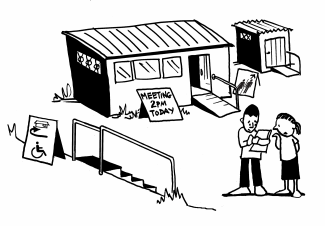Submitted by
ManuelRothe
on
Fri, 09/27/2019 - 08:26

© Julie Smith
In case it is your first time to plan an inclusive meeting or focus group discussion, consult with women and men with different types of disabilities and different ages (including children and older persons). This is the most effective way to ensure that nothing is overlooked.
For an accessible meeting venue, make sure:
- The place is easy to reach and transport is provided for those who cannot walk for long distances.
- The entrance is step-free. If not, install a ramp.
- Toilets, washrooms and the eating places are accessible and well signed.
- There is good lighting for people with visual impairments.
- Chairs are provided for people who find it hard to sit on the floor.
Think of the chain of movement of different persons, from their homes to the meeting place, from the entrance to the meeting room, the toilet and catering place.
Remember:
- Communication about the meeting should reach everyone, including people who are deaf or blind.
- Some persons with disabilities and older persons have personal assistants or caregivers with them, plan this ahead of the meeting
- Women and girls with disabilities are often underrepresented and organisations should strongly promote their participation
Sources
ESCAP. Disability Inclusive Meetings. An Operational Guide. 2015
ParlAmericas. Strategies for Chairing Gender-Inclusive Meetings. 2015.
Pacific Disability Forum (PDF). Fiji Disability Inclusive Community Based Disaster Risk Management Toolkit. 2013